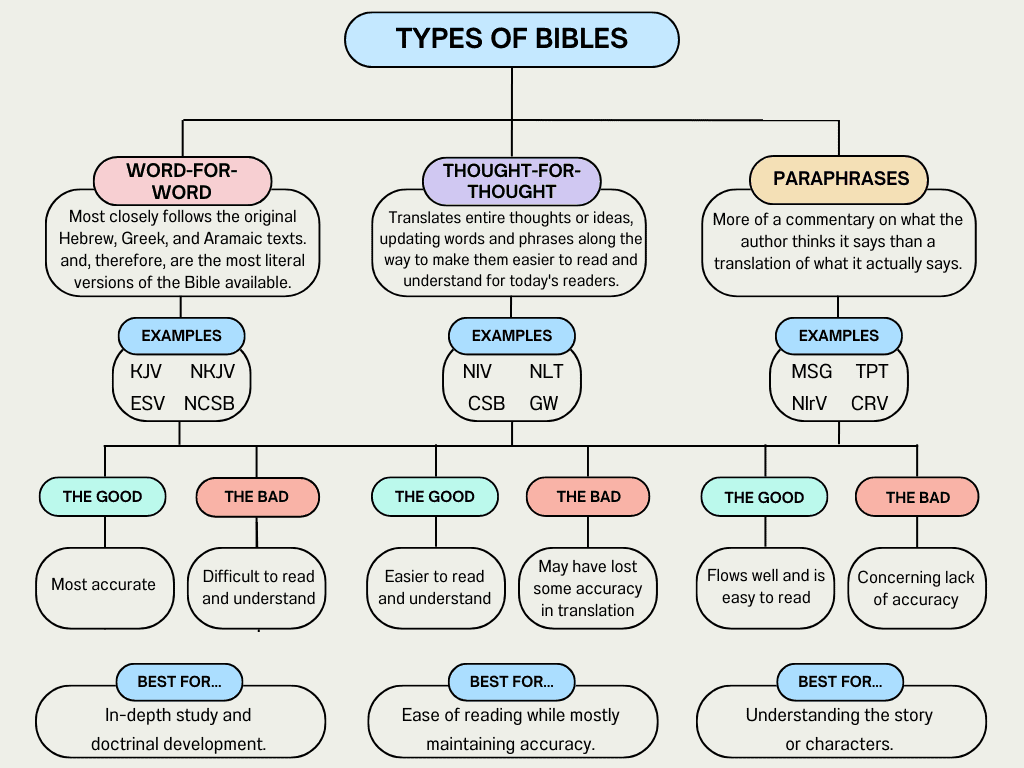So Many Different Bible Versions! Which is Best?
If you’ve ever perused the Bible section at your local bookstore or looked up “Bible” on Amazon, you probably noticed that there are a lot of options to choose from. Like A LOT! Then you probably asked yourself, “With so many different Bible versions and types of Bibles out there, which one should I read?” If that’s you, stick around! In this post, I’m going to talk about why there are so many and how to choose one that’s right for you!
Contents
Why Are There Different Versions of the Bible?
Not only are there different types of Bible translations and many versions within those categories, there are often many editions of each version. What gives? Why have people bothered to put forth the effort to create so many different Bibles?
One big reason for so many translations is that there are a lot of manuscripts that have been copied over time. According to this article on Christianity.com, “there are over 5,800 Greek New Testament manuscripts known to date, along with over 10,000 Hebrew Old Testament manuscripts and over 19,000 copies in Syriac, Coptic, Latin, and Aramaic languages.” Each of these manuscripts uses different words in their own language to get across the same meaning. So when they are each translated into English, the translator will use different English words that convey the same meaning.
Add to this the fact that the English language has changed over time, and you get a lot of different versions of the Bible produced at different times in history.
Also, people need different versions for different uses. Think about it, people study the Bible, they preach from the Bible, they use it to solidify doctrinal beliefs and put to rest doctrinal differences, and they use it to grow their faith. While one type of Bible will be great for casual reading, another will be better for deeper study.
{Related: What Does the Bible Say About Faith?}
Does This Mean That the Bible Can’t Be Trusted?
Is it possible that with so many different translations you can no longer be sure of the Bible’s original meaning?
Not at all! Think about it like this…you can ask different people the same question, say, “How are you?” and get many different answers that all have basically the same meaning.
- “Doing well, thanks.”
- “Everything is copacetic.”
- “Never better!”
- “No complaints here!”
- “Couldn’t be better!”
Even though these translations all use different words, they all convey the same idea. These people are all communicating that they are satisfied with their current situation. The different words used doesn’t make any one person’s answer any less believable than the others.
Even though scholars disagree on some translations of certain passages, these instances are few and far between. And a good Bible will include a footnote when this is the case, ensuring that you can be confident that nobody is trying to pull the wool over our eyes.
Also, the fact that there are so many reliable translations available to us makes it easier to spot when a translation may be off. For example, the Jehovah’s Witnesses translation, the New World Translation (NWT), translates John 1:1 as “and the Word was a god,” while the same verse in every other major translation reads “and the Word was God.” Obviously, the authors of the NWT have done something with this verse that the authors of the other translations don’t agree with. A study of the use of article adjectives (a, an, the) in the original Greek would lead you to conclude that the word “a” doesn’t belong in this verse and that the NWT has been written to protect a doctrine that doesn’t exist in most other Christian belief systems.
For more on this type of analysis of the Bible, check out this article!
How Many Types of Bibles Are There?
While there are more than 60 different Bible translations on the market today, they can each be placed into one of 3 major categories.
- Word-for-word translations
- Thought-to-thought (or meaning-to-meaning) translations
- Paraphrapases
If you want to know which type of Bible you’re looking at, take a look at the front of the Bible. You’ll usually find an explanation of which approach was used in its preparation there.
Word-for-Word Translations
Word-for-word translations most closely follow the original Hebrew, Greek, and Aramaic texts. and, therefore, are the most literal versions of the Bible available. Some examples of word-for-word translations are the King James Version (KJV) and the New King James Version (NKJV).
A major pro of word-for-word translations is that, because they keep details like grammatical structure, vocabulary, and syntax of the source text, they are the most accurate types of Bible available.

A major con with these translations, however, is that they assume that the reader knows about the culture and language of the time the source texts were written. If you don’t, you’ll find these versions difficult to read and understand.
Choose a word-for-word translation if you value accuracy above all else AND are willing to dig deeper into the original languages and culture for context.
Thought-to-Thought Translations
Also known as meaning-to-meaning translations, these Bible versions translate entire thoughts or ideas instead of focusing on each individual word, updating words and phrases along the way to make them easier to read and understand for today’s readers. Some well-known examples of this type of Bible translation are the New Living Translation (NLT) and the New International Version (NIV).
To understand the difference between a more literal translation of the Bible and a version translated by idea, let’s look at a simple verse in John…
John 13:7 (KJV) – “Jesus answered and said unto him, What I do thou knowest not now; but thou shalt know hereafter.”
John 13:7 (NIV) – “Jesus replied, “You do not realize now what I am doing, but later you will understand.”
The idea Jesus is talking about in this verse isn’t a difficult one, but in the KJV, it is said in archaic language that forces readers today to read and reread the passage to understand what it says. The NIV
The main pro of this type of Bible translation is that they are much more readable and easier to apply to life today, which can be helpful for readers who are new to studying the Bible. However…
The main con of thought-to-thought translations is that some of the original meaning can be literally lost in translation, as some license may have been taken in interpreting the source texts as they were translated. This makes them problematic for readers still learning the basic tenets of Christianity (doctrine and theology), as many new Bible readers are.
Choose a meaning-to-meaning version of the Bible if you are new to reading the Bible or if you already have a strong grasp on doctrine and theology.
Paraphrases
Paraphrased versions of the Bible are the least accurate versions and can’t even truly be callled “translations.” The authors of these types of Bibles have exercised a lot of creativity and have applied their personal understanding of the Bible to their interpretation. These Bibles are more of a commentary on what the author thinks it says than a translation of what it actually says. Some examples of paraphrased Bibles are The Message (MSG) and The Passion Translation (TPT)
A major pro of paraphrased Bibles is that they are a lot easier to read and they flow more like a novel than other types of Bibles.

The main con of these versions of the Bible is that they oftentimes err in translating major ideas due to the poetic and interpretive license taken by the authors. The Passion Translation even leaves out entire verses altogether!
Choose a paraphrased Bible with caution! Only use one alongside a more literal translation to gain a better understanding of scripture, and always keep in mind that the interpretation applied by the author may not be accurate.
Names of Bibles by Type
If you’re now asking, “What are the different translations of the Bible?” here’s a handy Bible versions list you can use to know which common version belongs in each of the different groups of translations.
- Word-for-Word Translations
- New American Standard Bible (NASB)
- English Standard Version (ESV)
- King James Version (KJV)
- New King James Version (NKJV)
- Thought-for-Thought Translations
- Christian Standard Bible (CSB)
- New International Version (NIV)
- New Living Translation (NLT)
- Paraphrased Bibles
- New International Reader’s Version (NIRV)
- The Message (MSG)
- The Passion Translation (TPT)
- Contemporary English Version (CEV)

Here’s a visual of the types of Bibles. I’ve also seen it as a continuum, which may be a little more accurate, now that I’m thinking about it. Some word-for-word translations lean a little more into the thought-for-thought and vice versa, while some thought-for-thought translations lean a little more liberal with their interpretations putting them closer to the paraphrase category, but I hope you still find this succinct and helpful.
What Bible Version Should I Read?
Because there are so many different Bible versions, it can seem daunting to choose just one. So why choose just one? I actually prefer to use several different translations of the Bible when I study. I typically start with a more readable thought-for-thought version, like the NLT or CSB. I also like to have a hard-copy NKJV study bible handy. And the YouVersion Bible app makes it super easy to compare whatever versions I like to get a well-rounded idea of what each verse is talking about.
With a little experimentation and help from the Holy Spirit, you’ll find the right combination of Bible translations for your purposes. There really is no one right answer to this question; feel free to use different versions or editions for different things. Doing so will greatly increase your understanding of God’s word and grow your faith!
So what versions of the Bible do you like to read for which purposes? Comment below and let us know!
Catch ya’ later!






